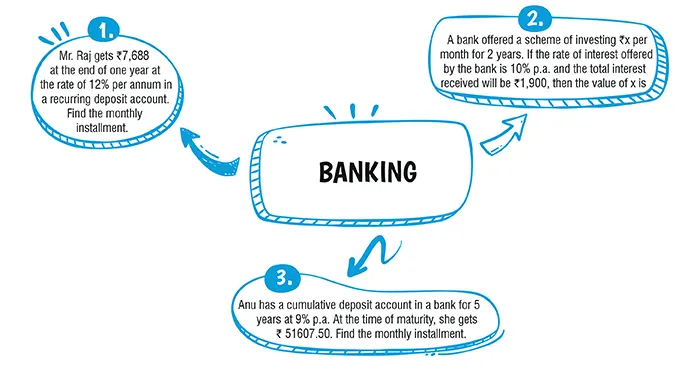Table of Contents

Ans. (a) ₹ 600
Explanation:
MV=P×n+P×\frac{n(n+1)}{2×12}×\frac{r}{100} \\
\Rightarrow 7,668=P\begin{pmatrix} 12+\frac{12×(12+1)}{2×12}×\frac{12}{100}\end{pmatrix} \\
\left[\because n=1 \space \displaystyle{year}=12\space \displaystyle{months} \right] \\
⇒ 7,668=P\begin{pmatrix} 12+\frac{78}{100}\end{pmatrix} \\
\Rightarrow 7,668=P\begin{pmatrix} 12+\frac{1,278}{100}\end{pmatrix}\\
⇒ P = 600
Ans. (d) ₹ 760
Explanation:
we have
P = ₹ x, n=2 years = 24 months, r = 10% and
I = ₹ 1,900
We know,
I = P × \frac{n(n+1)}{2×12}×\frac{r}{100} \\
⇒ 1,900 \\
= x × \frac{24×25}{24} × \frac{10}{100}\\
⇒ 1,900 = 2.5 x
⇒ x = 760.
Explanation:
(a) Since, number of months (n) = 24 and rate of interest (r) = 6%
I = P ×\frac{n(n+1)}{2×12} × \frac{6}{100} \\
⇒ 1200 = P × \frac{24(24+1)}{2×12} × \frac{6}{100} \\
⇒ P = \frac{24(24+1)}{2×12} × \frac{6}{100}\\
= ₹ 800
∴ Monthly instalment = ₹ 800 Ans.
(b) Sum deposited = ₹ 800 × 24
= ₹ 19200
Amount on maturity = ₹ 19,200 + ₹ 1,200
= ₹ 20,400 Ans.
Explanation:
we have,
n = 5 year = 5 × 12 = 60 months, r = 9% M.V. = ₹ 51607.50.
Since,
I = P× \frac{n(n+1)}{2×12} × \frac{r}{100} \\
= P × \frac{60×61}{2×12} × \frac{9}{100} \\
= \frac{549P}{40} \\
∴ M.V. = Pn + I \\
= P × 60+ \frac{549P}{40} \\
= \frac{2400+549P}{40} \\
= \frac{2949P}{40} \\
\text{According to the question,} \\
=\frac{2949P}{40} \\
= 51607.50 \\
⇒ P =\frac{51607.50×40}{2949}
∴ P = ₹ 700.
Explanation:
Here we have Ranajit Bhattacharya.
P = ₹ 10000, time = 6 years 6 × 12 = 72 months and we have to find r%
Clearly,
MV = P × n + P ×\frac{(n)(n+1)}{2×12} × \frac{r}{100} \\
\text{(i) so that we get.} \\
8,84,250 = ₹ 10000 × 72 + \frac{(72)(78)}{24} × \frac{r}{100}, \\
on solving we get: r% = 7.4%
Now for Lt Colonel Jayant:
P = ₹ 10000, time = 6 years 6 × 12 = 72 months and we have to find r% His maturity value is ₹ 19.710 less than the maturity value of Mr Ranajit:
I.e. ₹ 8,84,250 - ₹ 19.710 = ₹ 8,64,540 and rate is not known. Let it be R%
Clearly, ₹ 8,64,540
= ₹ 10,000 × 72 + = ₹ 10000 × \frac{(72)(78)}{24}×\frac{R}{100}, \\
on solving for R We get: R% = 6.6%
So the difference between the rate% = 7.4%- 6.6% = 0.8% Ans.
Download Mind Map of this chapter
Download NowWant to Practice Mock Tests of this chapter
Practice NowDownload Important Questions of this chapter
Download Now| Chapter No. | Chapter Name |
|---|---|
| Chapter 1 | Goods and Service Tax (GST) |
| Chapter 2 | Banking |
| Chapter 3 | Shares and Dividends |
| Chapter 4 | Linear inequations |
| Chapter 5 | Quadratic Equations in one variable |
| Chapter 6 | Ratio and proportion |
| Chapter 7 | Factorization |
| Chapter 8 | Matrices |
| Chapter 9 | Arithmetic Progression |
| Chapter 10 | Geometric Progression |
| Chapter 11 | Coordinate Geometry |
| Chapter 12 | Reflection |
| Chapter 13 | Similarity |
| Chapter 14 | Loci |
| Chapter 15 | Circles |
| Chapter 16 | Constructions |
| Chapter 17 | Mensuration |
| Chapter 18 | Trigonometry |
| Chapter 19 | Statistics |
| Chapter 20 | Probability |
| Chapter Wise Important Questions for ICSE Board Class 10 Mathematics |
|---|
| Goods and Service Tax (GST) |
| Banking |
| Shares and Dividends |
| Linear inequations |
| Quadratic Equations in one variable |
| Ratio and proportion |
| Factorization |
| Matrices |
| Arithmetic Progression |
| Geometric Progression |
| Coordinate Geometry |
| Reflection |
| Similarity |
| Loci |
| Circles |
| Constructions |
| Mensuration |
| Trigonometry |
| Statistics |
| Probability |
CBSE Important Questions Class 10
ICSE Important Questions Class 10
CBSE Important Questions Class 10
ICSE Important Questions Class 10